Perverse passions that will not die: The modern vampire first walked among us two centuries ago
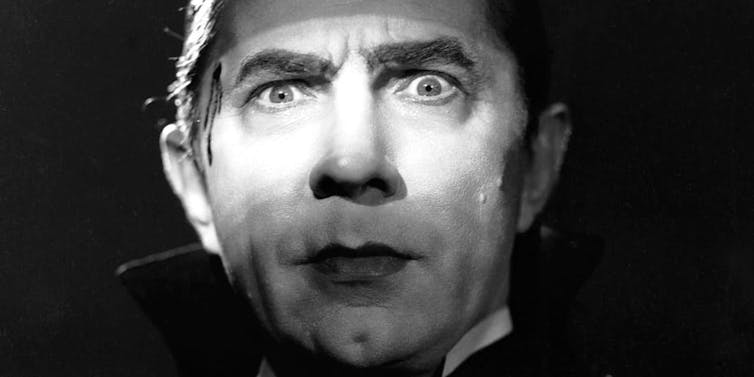
Bela Lugosi’s portrayal of Dracula in Tod Browning’s 1931 horror film is influenced by John Polidori’s tale of terror, ‘The Vampyre,’ first published — suggestively — on April Fools’ Day 1819. Universal Pictures Robert Morrison, Queen's University, Ontario
Vampires have stalked humans for thousands of years, but it was just two hundred years ago that a young English doctor named John Polidori introduced the modern version of the ancient demon.
Although far less well-known than Bram Stoker’s Dracula, Polidori’s The Vampyre was first published — suggestively — on April Fools’ Day 1819. This brief tale of terror set the pattern for all future representations of the vampire, including Stoker’s, and it launched a vampire craze that after two centuries still retains its ability to grab us by the throat.
It is hard to imagine, but The Vampyre as well as Frankenstein, two of western literature’s most enduring myths, were the results of the same ghost story writing contest.
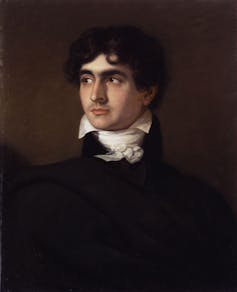
A portrait of John Polidori by F. G. Gainsford, circa 1816. F G Gainsford/National Portrait Gallery
Vampires today inhabit a wide realm of the popular imagination in everything from novels, films and television shows to cartoons, video games, comic books and advertisements. They are also a powerful metaphor for conceiving and representing all manner of cultural practices and social problems, from the spread of sexually transmitted disease, through the mental and bodily pains of drug addiction, to the many ways in which technology and social media penetrate our daily lives.
The writing contest
Handsome, arrogant and hot-tempered, Polidori was educated at a Catholic boarding school and then at the University of Edinburgh, where in 1815 he received his medical degree at the age of just 19. Less than a year later, the course of his life changed dramatically when Lord Byron, the most famous literary man of the day, hired him as his travelling companion and personal physician.

The poet Lord Byron, oil on canvas, circa 1835, based on a work of 1813. Thomas Phillips/National Portrait Gallery
Quick to see the commercial potential of the arrangement, Byron’s publisher, John Murray, commissioned Polidori to keep a diary of his time with the notorious poet, whose passionate interest in young men and scandalous love affair with his half-sister Augusta had hastened his departure from England.
Polidori immediately saw the predatory side of Byron’s personality. “As soon as he reached his room,” Polidori wrote from Belgium in April 1816, “Lord Byron fell like a thunderbolt upon the chambermaid.”
Shortly thereafter, Byron and Polidori took up residence at the Villa Diodati on Lake Geneva. Polidori saw himself as a rival to Byron and relations between them soon deteriorated. “What is there excepting writing poetry that I cannot do better than you?” Polidori demanded.
“First,” Byron snapped in reply, “I can hit with a pistol the keyhole of that door – Secondly, I can swim across that river to yonder point – and thirdly, I can give you a damned good thrashing.”
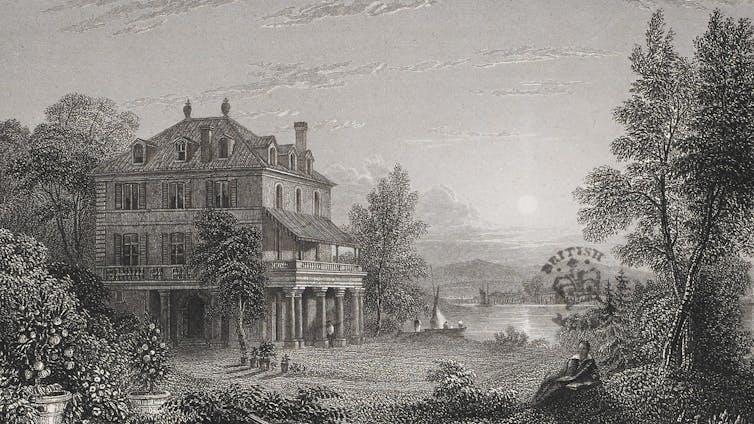
The site of the ghost story writing contest: Villa Diodati at Lake Geneva, 1833. Edward Finden/British Library
The aristocrat and his doctor were soon joined by a like-minded trio of literary and sexual renegades: the radical poet and free-love advocate Percy Bysshe Shelley, his 18-year-old lover Mary Wollstonecraft Godwin, and Mary’s stepsister Claire Clairmont, also 18 and Byron’s most recent amour. It was an extraordinary meeting of minds and bodies.
Bad weather kept the group indoors, and in mid-June Byron challenged each of them to write a ghost story. Claire defaulted. Shelley may have produced a brief verse fragment as his contribution to the competition. Byron started but did not complete the short tale of terror now known as Augustus Darvell.
The winners are…
Godwin (the future Mary Shelley) and Polidori each produced a finished and immensely influential work. She created Frankenstein. He composed The Vampyre.
These spectacular results make the competition the most famous in all of English literary history. It is a striking thought that the same writing contest gave us both Frankenstein and The Vampyre, the two most enduring myths of the modern world.
Before Polidori, vampires were very different creatures. Shaggy, fetid and bestial, they preyed on family members, neighbours or livestock in nocturnal raids that in many accounts approached both the risible and the revolting. Polidori changed all that.
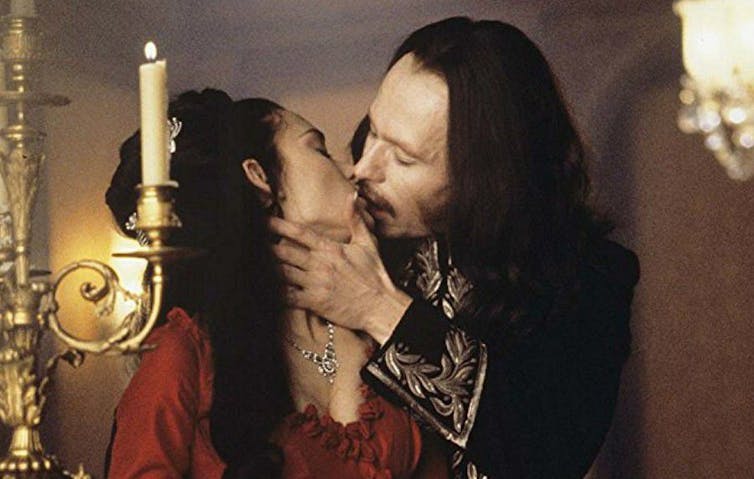
After Polidori, vampires became handsome predators, creatures of polite society.
His vampire was highly resourceful and haunted, not the village or the district, but the drawing rooms of polite society and the pleasure dens of international travellers. What is more, instead of the peasant-turned-ghoul of ancient folklore, Polidori elevated the vampire to the ranks of the aristocracy, where as a hypnotically handsome predator he seduced beautiful young women and sucked their life away.
Polidori’s tale centres on fatal vows, paralysis, isolation, betrayal and the return of the dead. He clearly models his vampire, Lord Ruthven, on Lord Byron, for the two have in common good looks, callousness, high rank, mobility, wealth and keen sexual appetites. Aubrey is Ruthven’s friend and travelling partner, and his relationship with Ruthven is usually read as Polidori’s own complex fascination with Byron — a fascination that both attracts and appals him.
In the tale, Ruthven sucks strength from Aubrey as their relationship declines, but he takes a much more deadly interest in Aubrey’s unnamed sister and Aubrey’s close friend, Ianthe, both of whom he dispatches with his insatiable fangs:
“Upon her neck and breast was blood, and upon her throat were the marks of teeth having opened the vein: – to this the men pointed, crying, simultaneously struck with horror, ‘a Vampyre, a Vampyre!’”
A 200-year-long fascination
There have been many more sophisticated and explicit renderings of vampiric lore in the two centuries since Polidori’s tale first appeared. Joseph Sheridan Le Fanu popularized the female vampire in his tale of terror Carmilla (1872), Stoker took the lordly fiend to new heights in Dracula (1897) and over the course of the last 100 years novelists, poets, playwrights, artists, movie makers and screenwriters have returned obsessively to vampires.
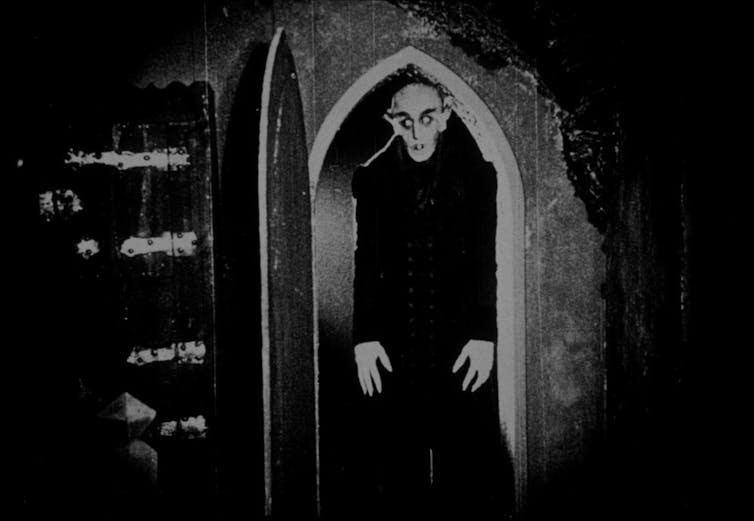
A scene from the 1922 silent horror classic, ‘Nosferatu,’ influenced by Bram Stoker’s ‘Dracula.’
Polidori’s tale touched off this fascination. Two centuries ago he corrected the drastic deficiencies of the folklore and reimagined the vampire as a suave, mysterious, sexually dynamic elite who defies time and place, who consumes ravenously and without guilt, and who represents perverse passions that will not die.
But the spread of vampirism does not end there. Vampires terrify us now because, in the hands of the countless writers and artists who have drawn their creative lifeblood from Polidori’s reincarnation, they serve as potent and protean representations of whatever we most fear about foreignness, sexuality, selfhood, disease, the afterlife, history and much else. They represent our undying urge for gratification. They embody the monstrous return of what we bury both in ourselves and in our collective past.
![]()
Robert Morrison, Professor of English Language and Literature, Queen's University, Ontario
This article is republished from The Conversation under a Creative Commons license. Read the original article.
« Voix de la SRC » est une série d’interventions écrites assurées par des membres de la Société royale du Canada. Les articles, rédigés par la nouvelle génération du leadership académique du Canada, apportent un regard opportun sur des sujets d’importance pour les Canadiens. Les opinions présentées sont celles des auteurs et ne reflètent pas nécessairement celles de la Société royale du Canada.


